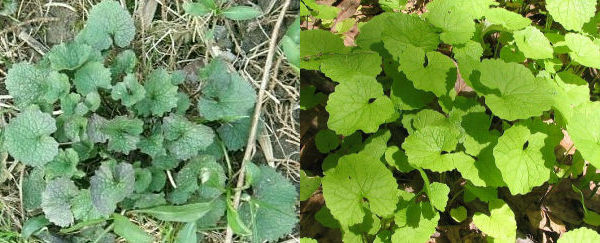
Despite the cold and potential for snow I keep looking for signs of spring.
There’s not a lot out there. I found small bittercress and coltsfoot blooming on south-facing slopes last Sunday and I found rosettes of these leaves, noticable because they had a purplish tinge all winter (photo at left) and now they’re turning green (photo at right).
This is Garlic mustard (Alliaria petiolata) a biennial plant native to Europe, Asia, and Africa. Whether it hitchhiked to North America or was intentionally imported as a culinary herb (it tastes like garlic) it hasn’t been here all that long. It was first recorded on Long Island in the 1860s.
Since then garlic mustard has invaded the ecological niche occupied by our favorite spring plants. It easily becomes the dominant plant of forest and floodplain because:
- It starts growing in the spring before our native plants dare show their heads.
- Its seeds are viable for five years.
- It produces allelochemicals that suppress the good fungi our native plants rely on, and
- Deer don’t eat it. 🙁
So though I’m usually happy to find green leaves in March, these are not a good sign.
For more information on garlic mustard and what you can do about it, click here.
(photo on left by Marcy Cunkelman, photo on right from Wikimedia Commons.)
HATE this stuff! Are there groups in your area that do Garlic mustard pulls? In Southeast Michigan the Stewardship Network organizes a challenge each year to see who among their clusters or groups can pull the most. I read the other day that over 500,000 pounds has been pulled over the last several years.
I also hate this stuff! I’m in UK and look after a little local park. One border is full of Garlic Mustard. I’m reassured that I’m doing the right thing – last year I prevented flowering and this year I’ve started to dig up the plants. However, I was composting them and will now stop doing that!
Thanks for the reminder, Kate. I only became aware of this plant last year, when it starting taking over large areas of my back yard. You really need to pull it before it goes to seed, as the seeds scatter to the four winds when disturbed. I’ve already started looking out for it this year.